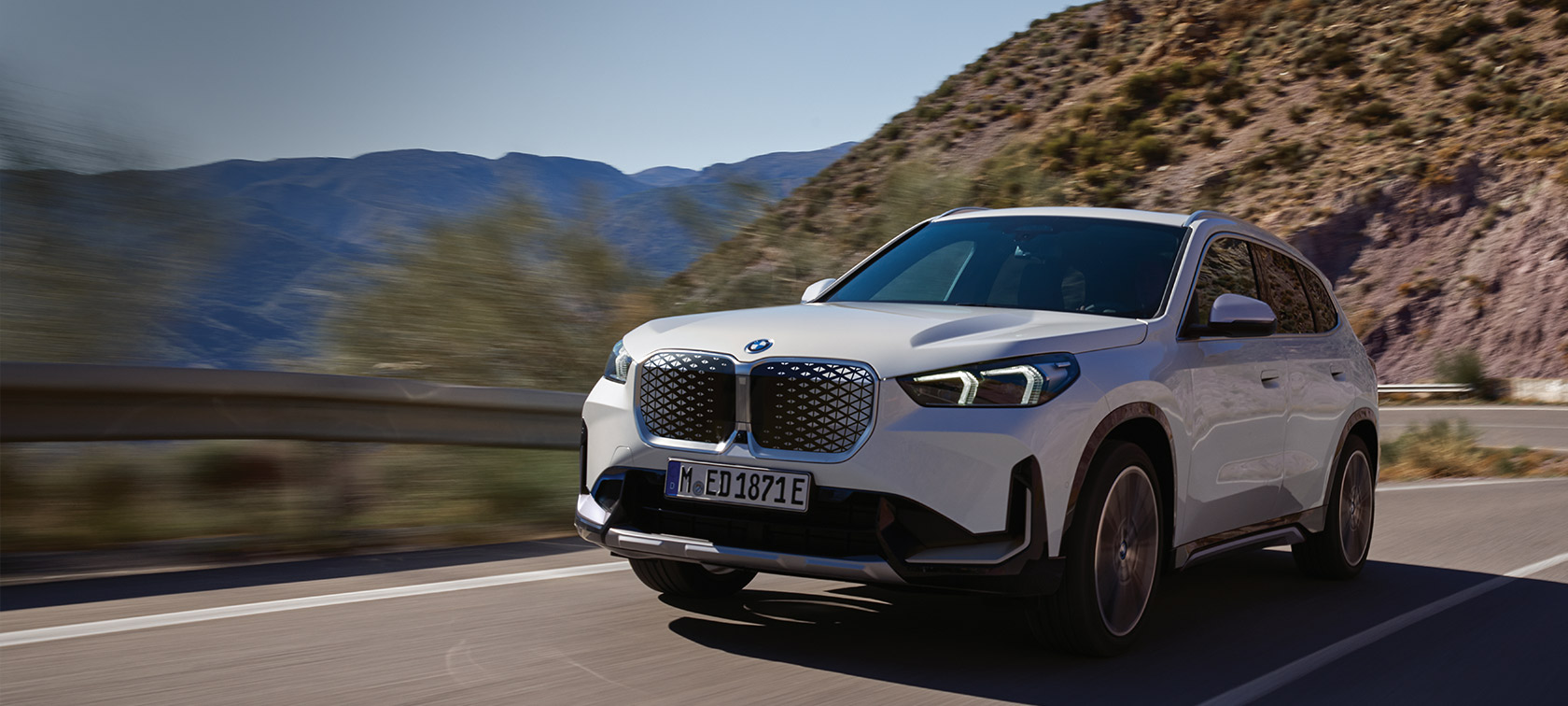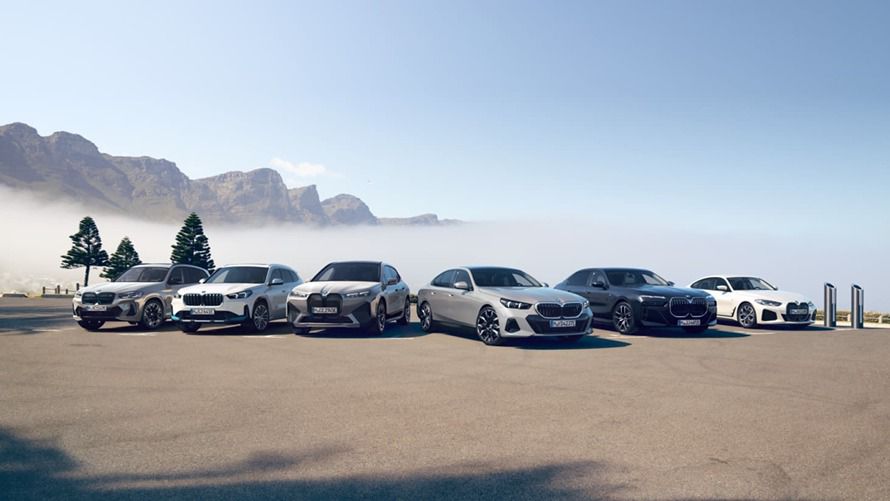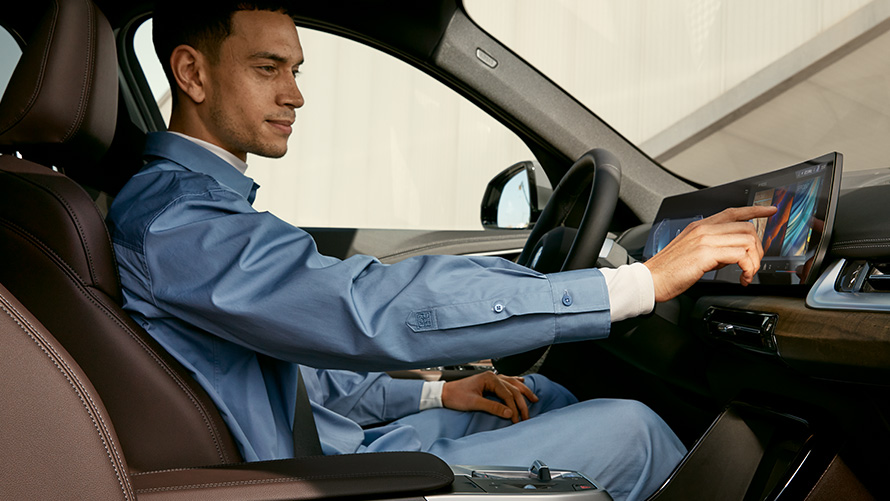Our tool for managing your permission to our use of cookies is temporarily offline. Therefore some functionality is missing.

The fully electric BMW iX1 xDrive30 and BMW iX1 eDrive20 radiate electrifying determination and with its functionality and versatility provide inspiration to pursue new paths even in everyday use:
- Self-assured presence on the exterior thanks to the monolithic design language and distinctive proportions
- Supreme comfort in the interior thanks to active seats with massage and lumbar function for fatigue-free sitting comfort
- Modern multimedia cockpit due to the innovative BMW Curved Display with touch and voice control concept
- Full flexibility with a range of up to 439 km for the BMW iX1 xDrive30 and up to 474 km for the BMW iX1 eDrive20
BMW iX1 xDrive30:
Energy consumption, combined WLTP in kWh/100 km: 18.1-17.0
Electric range, WLTP in km: 417-437
BMW iX1 eDrive20:
Energy consumption, combined WLTP in kWh/100 km: 17.2–15.4
Electric range, WLTP in km: 430–474
CHOOSE YOUR LOOK FOR THE BMW iX1.
THE DRIVING DYNAMICS OF THE BMW iX1.

RANGE AND CHARGING OF THE BMW iX1 xDRIVE30.

- Also the ideal companion for impromptu tours: with a range of up to 437 km (WLTP)
- Recharge up to 120 km of range in only 10 minutes
- Recharge up to 80% of the range in 29 minutes at public high-speed charging stations
- Low consumption of only 18.1–16.9 kWh/km through technologies such as recuperation during braking
- Maximum efficiency thanks to lightweight construction methods and aerodynamic design
Why do the ranges vary?
The respective range of an electric vehicle depends on various factors such as driving style, route conditions, vehicle equipment, weather conditions and payload.
In detail
High average speeds (highway) reduce the range most significantly, while inner-city traffic leads to a higher range due to lower speed and higher recuperation shares (in contrast to vehicles with internal combustion engines). Furthermore, the range is reduced at low temperatures due to heating, and high temperatures with strong air conditioning. Regarding the special features/equipment, the selection of larger tire combinations generally reduces the range (if the aerodynamic disadvantage is not compensated for by a more closed wheel design). The rolling resistance class of tires is also relevant for the range: e.g. the use of a winter tire reduces the range compared to a Label A summer tire.
General range specification and range values in this indicator
In the model selection, the communicated range is based on the WLTP (Worldwide harmonized Light-Duty Test Procedure) cycle.
WLTP enables a calculation of the range under prescribed driving conditions. WLTP assumes a defensive driving style with a route mix of city streets, country roads and highways.
The range indicator enables you to estimate the range under your typical driving conditions. The outer circle represents the calculated range value based on linear distances (not the actual street map), while the inner circle shows the calculated value -30% to take the real-life routes into account.
What are the assumptions underlying the driving style settings?
Setting a "sporty" driving style assumes 100% highway driving with an average speed of approximately 130 km/h and a dynamic overtaking style. The "economical" setting assumes defensive driving on country roads with an average speed of around 80 km/h. Settings in between produce a mixture of both.
CHARGING TIMES FOR 100 KM RANGE.

Charging at home for a range of 100 km.
01:32 h – Wallbox (11 kW)
01:32 h – Flexible Fast Charger (11 kW) on industrial socket
07:41 h – Standard charging cable or Flexible Fast Charger (2.3 kW) on household socket

Charging on the road for a range of 100 km.
00:08 h – High-power charging station (max. vehicle charging capacity)
00:19 h – Fast charging station (50 kW)
00:55 h – AC charging station (max. vehicle charging capacity)
The charging performance depends on the state of charge, ambient temperature, individual driving profile and use of auxiliary consumers. The ranges shown are based on the WLTP best case. The charging times apply to ambient temperatures of 23 degrees Celsius after a preceding drive and may differ depending on the usage behaviour.
CHARGING TECHNOLOGIES OF THE BMW iX1.

BMW CHARGING: EASY. ANYTIME. EVERYWHERE.

Charging at home.
With the Flexible Fast Charger, your BMW iX1 already offers everything that you need for convenient charging at home right from the time of delivery. If you wish, you can further adapt the charging options to your own needs.

Charge in one of New Zealand’s largest networks.
With ChargeNow, operated by ChargeNet, you can have access to the largest network of public charging stations across New Zealand.

BMW Connected Charging Services.
In the vehicle or in the My BMW App, you can receive detailed information or discover routes optimised for charging: this makes charging convenient and easy.
EXTERIOR DESIGN OF THE BMW iX1.

EXTERIOR HIGHLIGHTS OF THE BMW iX1.

Front Design.
The distinctive and large, almost square double kidney grille and the slim Adaptive LED highlights, extending far into the flanks, give the BMW iX1 a powerful and electrifying presence.

Side view.
With its prominent front section and upright proportions, the BMW iX1 presents an extremely dynamic image in the side view. Its exterior is characterised by short overhangs and a long wheelbase typical of a Sports Activity Vehicle.

Rear view.
Thanks to their interplay of transparent and dark smoked glass together with the hexagonal pattern[1] in the side, the three-dimensional L-shaped rear lights deliver an unmistakably modern statement.
INTERIOR DESIGN OF THE BMW iX1.

INTERIOR HIGHLIGHTS OF THE BMW iX1.

Intuitive controls in the cockpit.
Fewer buttons, more intuition: the slim and frameless BMW Curved Display with touch and voice control is a true eye-catcher in the interior of the BMW iX1 and at the same time your key interface to BMW iDrive.

Modern central console.
Modern operating concept on two levels: the classic manual switches have gone and make way for a central console with a switch/sliding control, operating elements of the latest generation and the integrated wireless charging tray on the lower level[1].

Luggage compartment.
The illuminated luggage compartment of the BMW iX1 offers a wide variety of stowage options. Features such as the folding floor insert and the reclining angle adjustment for the rear seat backrests give you additional luggage space – and greater scope for spontaneity.
LARGE LUGGAGE COMPARTMENT AND THE TRAILER TOW HITCH OF THE BMW iX1.
INNOVATION AND COMFORT IN THE BMW iX1.
EXPERIENCE THE INNOVATION HIGHLIGHTS OF THE BMW iX1.



More information about My Modes.
BMW Maps.
More Information about Augmented View.



- Comfort
- Driver assistance

Active seat for driver and front passenger.
The oscillating seat base function provides optimum seating comfort with an electrically adjustable lumbar support incl. massage function.

Panoramic glass sunroof.
When open, the panoramic glass sunroof provides plenty of fresh air. When closed, it creates a welcoming, brightly lit atmosphere in the interior.

Trailer tow hitch.
The trailer coupling with electrically adjustable ball head. Trailer Stability Control and anti-theft security mounting increase safety.

Driving Assistant Professional.
The Driving Assistant Professional provides you with comprehensive support on all trips. A complete package for safety and comfort when traveling.

Reversing Assistant.
Also manoeuvres you out of challenging situations: the Reversing Assistant remembers the steering movements of the last 50 metres and automatically returns the vehicle precisely along the previously travelled path.

Parking Assistant.
Parking Assistant makes it easier for you to park and manoeuvre in tight spaces and prevents parking damage.
ORIGINAL BMW ACCESSORIES FOR THE BMW iX1.

21" M Performance light alloy wheel double-spoke style 877 M Bicolour.
21" M Performance light alloy wheel double-spoke style 877 M in Bicolour Jet Black uni, gloss-lathed. Summer complete wheel set with tyre pressure monitor.

BMW Roof Box 420 black/titanium silver.
Black/titanium silver lockable roof box, accessible from both sides with a capacity of 420 litres, compatible with all BMW roof rack systems.

BMW all-weather floor mats front.
The perfectly fitted BMW all-weather floor mats protect the front footwell against moisture and dirt. In Black with BMW lettering.
TECHNICAL DATA OF THE BMW iX1.
BMW iX1 xDrive30 and other engines.
Power in kW (hp) | 230 (313)[2] |
Maximum torque in Nm: | 494 |
Acceleration 0–100 km/h in s: | 5.6 |
Electric range in km (WLTP): | 417-437 |
Maximum charging capacity: | recharging for 10 min can add up to 135 km |

BMW FINANCIAL SERVICES FOR THE BMW iX1.
*The BMW iX1 eDrive20 recommended promotional price of $86,900 includes GST, excludes optional extras, on-road and delivery costs. Cannot be combined with any other offer from BMW New Zealand LTD. Available for vehicles purchased and delivered between 01/04/2024 and 30/06/2024 or while stocks last. Available at participating dealers.
Power consumption and range.
BMW iX1 xDrive30:
Energy consumption, combined WLTP in kWh/100 km: 18.1-17.0
Electric range, WLTP in km: 417-437
BMW iX1 eDrive20:
Energy consumption, combined WLTP in kWh/100 km: 17.2–15.4
Electric range, WLTP in km: 430–474
Some of the vehicles in the videos show equipment that is no longer available.
The values of fuel consumptions, CO2 emissions and energy consumptions shown were determined according to the European Regulation (EC) 715/2007 in the version applicable at the time of type approval. The figures refer to a vehicle with basic configuration in Germany and the range shown considers optional equipment and the different size of wheels and tires available on the selected model.
The CO2 efficiency specifications are determined according to Directive 1999/94/EC and the European Regulation in its current version applicable. The values shown are based on the fuel consumption, CO2 values and energy consumptions according to the NEDC cycle for the classification.
When charging times are shown they can be affected by a number of factors such as type of charger, voltage supplied to the charger/car and type of current (AC or DC) supplied to the charger/car. The car also plays a role in charging times as it can be set by the driver to accept various different amperage and should preconditioning be used to heat or cool the vehicle while charging this will also affect the charging time.
The basis for the calculation of the charging times for 100 km range is the electric consumption of the vehicle based on the use of a high-Powered Charging station (HPC) or charging type and current as indicted in the literature above. The testing procedure measures are based on a 23 degrees Celsius battery start and ambient temperature with certification values excluding additional auxiliary consuming devices and systems within the vehicle such as seat heating, displays, air conditioning.
Individual consumption (fuel economy) may differ due to driving profile, vehicle load profile, auxiliary consumer usage, temperature, and ambient conditions. Consumption is based on WLTP or NEDC (whichever is indicated) best case conditions and is independently tested for BMW Group. If you are comparing this range with other models or brands make sure they are stating the same WLTP or NEDC testing regime. These results can be used to compare vehicles on a close to “like for like” basis but are unlikely to be achieved in real world conditions for reasons including temperature variation, driving conditions and the use of the auxiliary systems referred to above.
Information provided and images displayed on this site include overseas models and may show some features not available in New Zealand. Please contact an authorised BMW dealer for specific information on vehicles and features available in New Zealand. Product changes may have been made since production of this content.
Power consumption and range.
BMW iX1 xDrive30:
Energy consumption, combined WLTP in kWh/100 km: 18.1-16.8
Electric range, WLTP in km: 417-440
* The performance depends on the state of charge of the battery.
The values of fuel consumptions, CO2 emissions and energy consumptions shown were determined according to the European Regulation (EC) 715/2007 in the version applicable at the time of type approval. The figures refer to a vehicle with basic configuration in Germany and the range shown considers optional equipment and the different size of wheels and tires available on the selected model.
The CO2 efficiency specifications are determined according to Directive 1999/94/EC and the European Regulation in its current version applicable. The values shown are based on the fuel consumption, CO2 values and energy consumptions according to the NEDC cycle for the classification.
When charging times are shown they can be affected by a number of factors such as type of charger, voltage supplied to the charger/car and type of current (AC or DC) supplied to the charger/car. The car also plays a role in charging times as it can be set by the driver to accept various different amperage and should preconditioning be used to heat or cool the vehicle while charging this will also affect the charging time.
The basis for the calculation of the charging times for 100 km range is the electric consumption of the vehicle based on the use of a high-Powered Charging station (HPC) or charging type and current as indicted in the literature above. The testing procedure measures are based on a 23 degrees Celsius battery start and ambient temperature with certification values excluding additional auxiliary consuming devices and systems within the vehicle such as seat heating, displays, air conditioning.
Individual consumption (fuel economy) may differ due to driving profile, vehicle load profile, auxiliary consumer usage, temperature, and ambient conditions. Consumption is based on WLTP or NEDC (whichever is indicated) best case conditions and is independently tested for BMW Group. If you are comparing this range with other models or brands make sure they are stating the same WLTP or NEDC testing regime. These results can be used to compare vehicles on a close to “like for like” basis but are unlikely to be achieved in real world conditions for reasons including temperature variation, driving conditions and the use of the auxiliary systems referred to above.
Information provided and images displayed on this site include overseas models and may show some features not available in New Zealand. Please contact an authorised BMW dealer for specific information on vehicles and features available in New Zealand. Product changes may have been made since production of this content.
Note: To obtain NZ CO2 figures for vehicles imported by BMW Group NZ in relation to the NZ Clean Car discount or “FeeBate” you will need to contact your preferred dealer. The Clean Car discount figures sourced from your dealer will differ from those listed in the BMW owner’s handbook and reported figures as they have been converted by the NZ government to WLTP3 from figures derived through one of the following testing procedures: WLTP4 or NEDC or Japanese JC08 mode or Japanese 10-15 mode or CAFE test cycle.
For all vehicles not imported by BMW NZ (Used vehicle imports) you will need to contact the source market for these CO2 figures as BMW Group NZ has no access to and cannot source this CO2 data.
For more information on the New Zealand Clean Car Programme, please visit https://www.nzta.govt.nz/vehicles/clean-car-programme/






